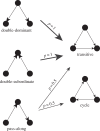The network motif architecture of dominance hierarchies
- PMID: 25762649
- PMCID: PMC4387537
- DOI: 10.1098/rsif.2015.0080
The network motif architecture of dominance hierarchies
Abstract
The widespread existence of dominance hierarchies has been a central puzzle in social evolution, yet we lack a framework for synthesizing the vast empirical data on hierarchy structure in animal groups. We applied network motif analysis to compare the structures of dominance networks from data published over the past 80 years. Overall patterns of dominance relations, including some aspects of non-interactions, were strikingly similar across disparate group types. For example, nearly all groups exhibited high frequencies of transitive triads, whereas cycles were very rare. Moreover, pass-along triads were rare, and double-dominant triads were common in most groups. These patterns did not vary in any systematic way across taxa, study settings (captive or wild) or group size. Two factors significantly affected network motif structure: the proportion of dyads that were observed to interact and the interaction rates of the top-ranked individuals. Thus, study design (i.e. how many interactions were observed) and the behaviour of key individuals in the group could explain much of the variations we see in social hierarchies across animals. Our findings confirm the ubiquity of dominance hierarchies across all animal systems, and demonstrate that network analysis provides new avenues for comparative analyses of social hierarchies.
Keywords: aggression; orderliness; peck order; social networks; transitivity; triad census.
© 2015 The Author(s) Published by the Royal Society. All rights reserved.
Figures





References
-
- Hawley PH. 1999. The ontogenesis of social dominance: a strategy-based evolutionary perspective. Dev. Rev. 19, 97–132. (10.1006/drev.1998.0470) - DOI
-
- Savin-Williams RC. 1979. Dominance hierarchies in groups of early adolescents. Child. Dev. 4, 923–935. (10.2307/1129316) - DOI
-
- Wilson EO. 2000. Sociobiology, 25th anniversary edn Cambridge, MA: Belknap Press.
-
- Chase I. 1980. Social process and hierarchy formation in small groups: a comparative perspective. Am. Sociol. Rev. 45, 905–924. (10.2307/2094909) - DOI
-
- Ellis L. 1995. Dominance and reproductive success among nonhuman animals: a cross-species comparison. Ethol. Sociobiol. 16, 257–333. (10.1016/0162-3095(95)00050-U) - DOI
Publication types
MeSH terms
LinkOut - more resources
Full Text Sources
Other Literature Sources
Miscellaneous
